The 2nd generation Toyota Sienta, a funky compact MPV, has been around in Singapore for a couple of months. I’ve been driving one for a while now. Although I was a little apprehensive about the size and performance if the vehicle initially, I’ve found that the MPV is pretty functional and quite fun to drive around.
Toyota introduced the first Sienta in 2003. It was powered by a 1.5l VVT-i engine and sported a rather uninspiring look.
The new Sienta looks radically different. It has an exterior design that Toyota describes as being inspired by a trekking shoe. The new design will invoke some strong reactions. To be completely honest, my first impression was that the Sienta’s front was so ugly. It resembled the look of a bull dog, and it didn’t quite look right on a car. But after you look at it for a few hours, the design actually does look quite appealing. The Sienta’s most recognisable colour is Air Yellow, which for some may be too loud and boisterous. However, other people may appreciate its boldness.
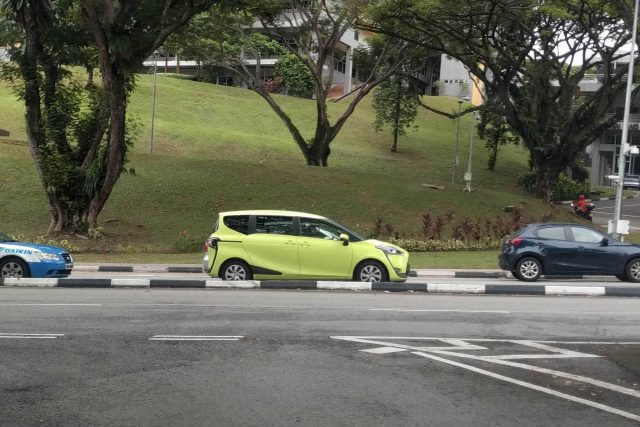
While the Toyota Sienta is designed to carry seven people, driver included, you might think it would be too tight for comfort. This was the first thing I set about to test when I got to check out the car. I’m not asking to fit adults into the 3rd row, but I thought it might even be small for children.
I adjusted the driver’s seat to sit myself comfortably. Then, I adjusted the second row seats to fit myself, before I finally sat myself in the third row. I was pleasantly surprised. Now, it’s clearly not spacious, and I don’t think you want to be cooped up in there for a long drive up to Malaysia, but average sized adults will fit in the third row. There is space under the second row seats to tuck one’s feet in. The space will suffice for a ride into town.
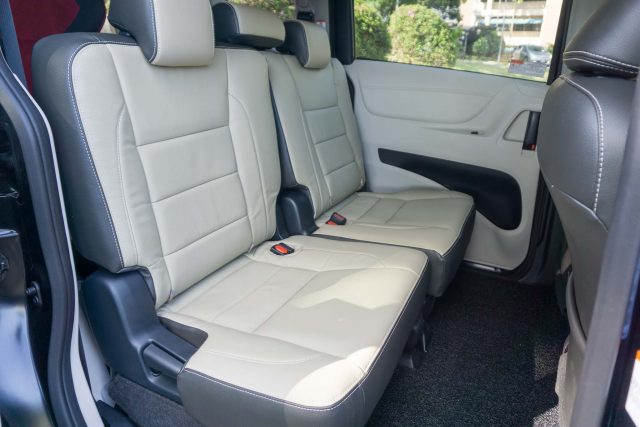
Oddly enough, it’s younger children with bulky child seats that might find the space a problem. The back of the second row seats may get just a little too close to bulky child seats, leaving little room left for legs to hang over the seat. I had to downsize a bulky child seat so that my youngest child can seat more comfortably.
For the driver, the Toyota Sienta is comparable to the Honda Stream, which I had been driving, in terms of space and comfort. If I had to nitpick a little, the Sienta is missing a foot rest for the left foot.
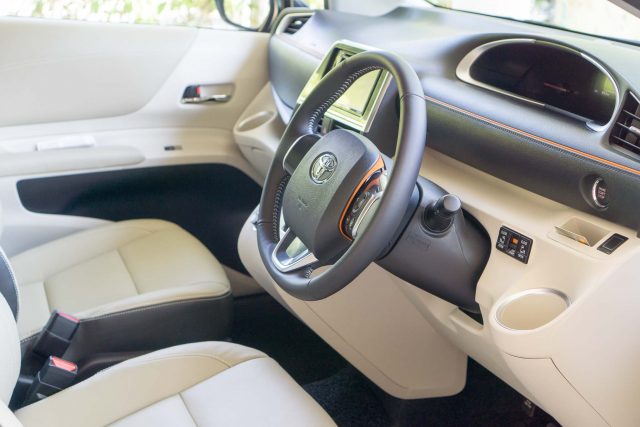
The instrument cluster sits high on the dashboard so you view them over the top of the steering wheel. The gear shift is on the centre dashboard, the way I like it, instead of on the floor between the front seats. In fact, the parking brake is a foot-operated one, so the space between the front seats is completely empty. This is for the JDM model; the Borneo Motors’ imported model has the gear shift and hand-operated parking brake between the front seats.
At this point, I should mention that I have the JDM model, which is different in a few ways from the Indonesian-made model sold through Toyota’s authorised dealer Borneo Motors (BM). There are also many variants and configuration options for JDM models, so to be clear, I have the Petrol 2WD “G” model with “LED Package”. This review is about what I have, and while I may occasionally point out differences from other models, don’t count on me to exhaustively list out all of them.
One feature that I love about the Toyota Sienta is the electric sliding doors. Depending on model, you either have a left-only electric powered sliding door, or have both doors electrically powered. Usually found only in larger and higher-end MPVs, the sliding doors provide a wide opening to make it more convenient to get in and out of the rear seats. In particular, with low floor and second row seats that fold up all the way front, getting into and out of the third row of seats is really easy.
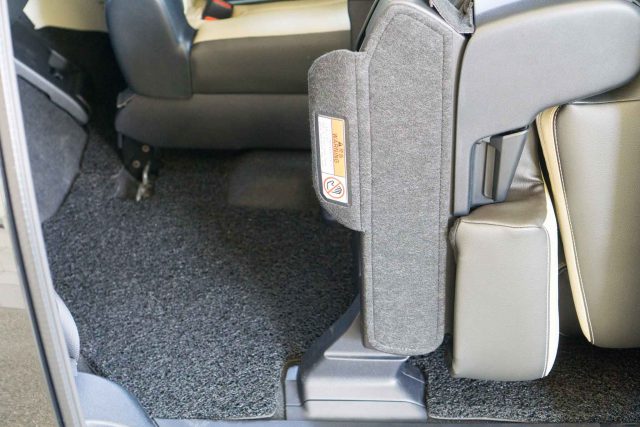
The electric doors can be operated by tugging gently on the door handle inside or outside, or by pressing on a one-touch button on the outside handle. The driver can also operate the door from dashboard controls. BM’s Sienta does not have the one-touch button on the handle. Electric power can be switched off, in which case you just operate the sliding doors manually.
The second row seats are a 50-50 split, which means it’s a little awkward for someone to sit in the centre straddling two seats. That seat does get the benefit of a proper three-point seatbelt, unlike lap belts common for many middle seats. There are ISOFIX attachments for child seats too.
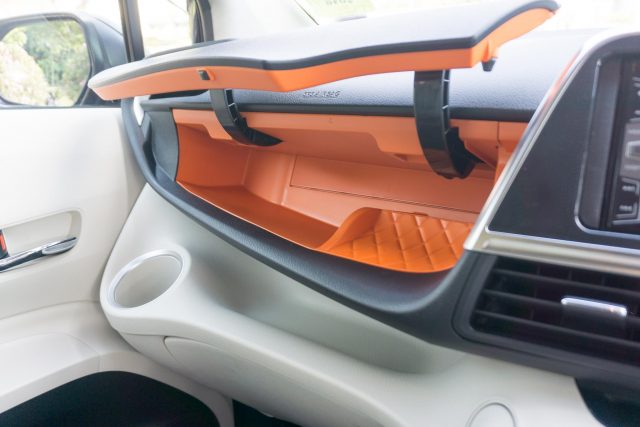
There is an abundance of storage compartments throughout the car, including two glove compartments and an open shelf on the front passenger side of the dashboard. There’s even a pocket beside the leg under the dashboard, not including the one on the door. On top of that, the front passenger also gets this hideaway hook that opens up to hang bags on.
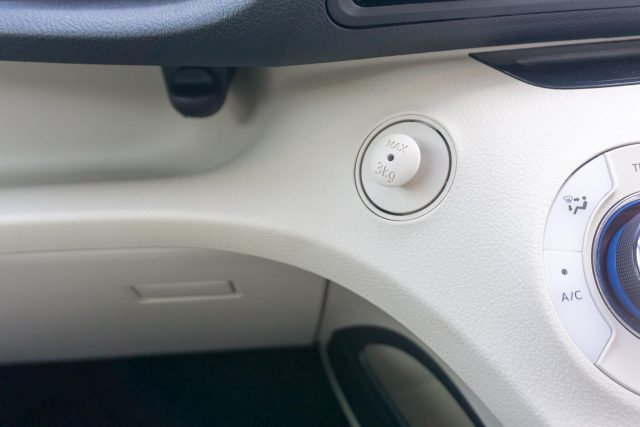
If I had to complain, the compartments might be plentiful, but they all aren’t very big. Sometimes, you might just want something more sizeable.
Rear aircon blowers are getting increasingly common in MPVs. The JDM Sienta, unfortunately, is missing those. The BM Sienta, however, does have the blower, although it’s not clear if it’s just a blower, or truly a rear aircon.
In terms of safety, the Toyota Sienta has a number of airbag options. Minimally, you get two airbags for the driver and front passengers. For JDM Sientas, you have the option to add side airbags and curtain airbags. BM’s Sienta has none of those options, but they do provide a driver’s knee airbag.
The Toyota Sienta is equipped with Anti-lock Brake System with Electronic Brake-force Distribution. Vehicle Stability Control with Traction Control, and Hill-start Assist Control, are standard for JDM models, but available only in the higher-end Elegance model from BM. Hill-start Assist Control is the feature that prevents a car from rolling downhill when you release the brake pedal, and before you can step on the accelerator pedal.
There are many smarts in the Toyota Sienta. Of course, my last car was in 2008, where many of these features are only for luxury cars, but has now become more widely available. Not everything is available in all Toyota Sienta models, but mine does come with electronic Engine Start Stop, as well as Stop & Start System. The Stop & Start System automatically stops the engine when the car is fully stopped, such as at a traffic light, and restarts immediately when you’re ready to move off. (Note the gadget with a LCD display in the lower right of the photo below is a Tyre Pressure Monitoring System, which is my own add-on.)
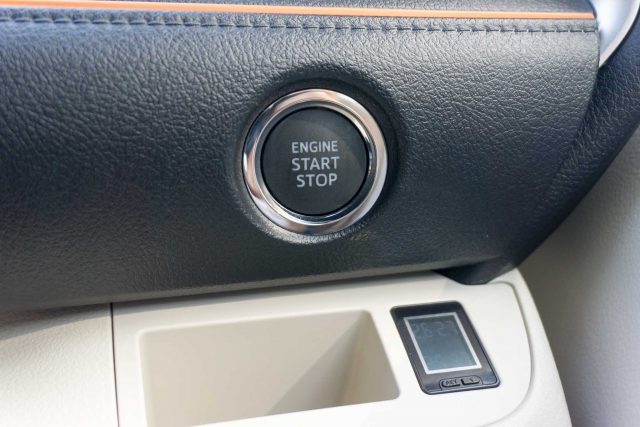
Getting into the car and setting off is really quite cool with the Smart Key System. You only need to have the key fob on you, but don’t actually have to use it to open the doors or start the engine. You can lock all doors simply by touching the designated part of the front door handles. Unlocking and opening the front doors couldn’t be easier, as you just need to pull on the handle.
On the key fob itself, you can lock and unlock all doors, and you can also remotely open and close the electric powered rear sliding doors.
Smart Start, Stop & Start, and Smart Key availability depend on model. The JDM “G” model has everything. Stop & Start is not available in BM’s Sientas.
I mentioned the “LED package”. This includes the LED clearance lamp (the outline light in the photo below), and Bi-Beam LED head lamp with auto-levelling function. Front halogen fog lamps are part of the package too.
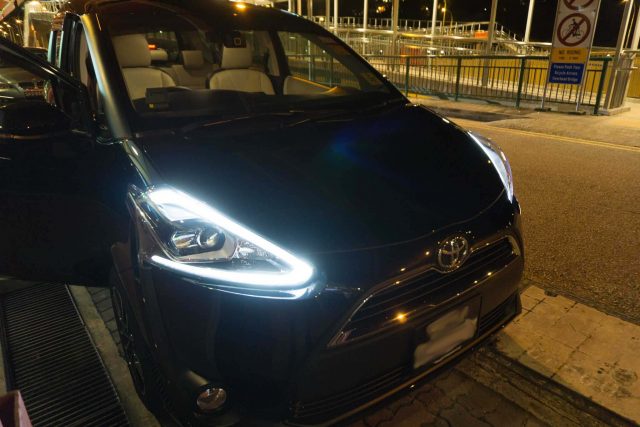
On the rear side, the “LED package” features the same clearance lamp style on the combination lamps. Additionally, there is automatic on-off control of the lights.
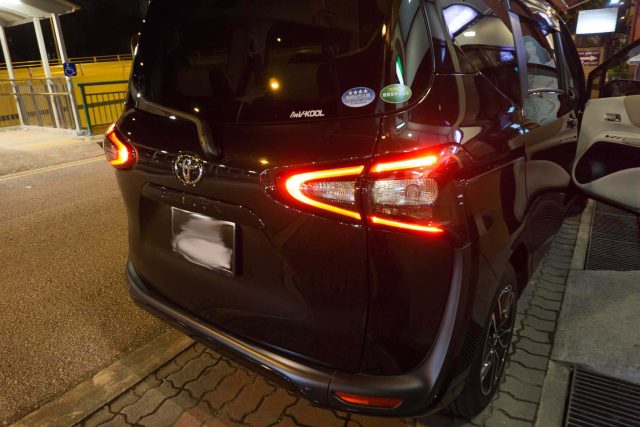
While the JDM models have no option for day running lights, the BM Sienta replaces the fog lamps with day running lights, and the LED head lamps are available only on the Elegance model.
With a 1.5l engine, you might expect that the Toyota Sienta would be rather sluggish. It’s not a light car, after all, weighing some 1320 kg (kerb weight). The 2NR-FKE engine, with VVT-iE, doesn’t look terribly powerful on the spec sheet either, putting out 80kw of power and 136N⋅m of tourque.
Despite the modest specs, it’s quite pleasant to drive the Toyota Sienta around the city. You’ll begin to feel the engine kicking in to accelerate from below 3000 RPM. Even if you’re really light footed, as I try to be during the break-in period, I can still do most of my city driving at under 2500 RPM. That’s with three adults and three children in my usual commute.
No, this isn’t a car that gets you across the traffic junction the moment the light turns green. This isn’t a car for aggressive driving, but it’s certainly adequate for driving the family around.
I don’t have any personal experience, but sharing by other car forum members, the Toyota Sienta can haul a family up Genting Highlands. Just for test sake, I’ve even driven up the steep slope at Lorong Sesuai at just 2000 RPM, and with the engine still in “ECO” region. It was very slow, but hey, that’s with family in the car going up a steep slope.
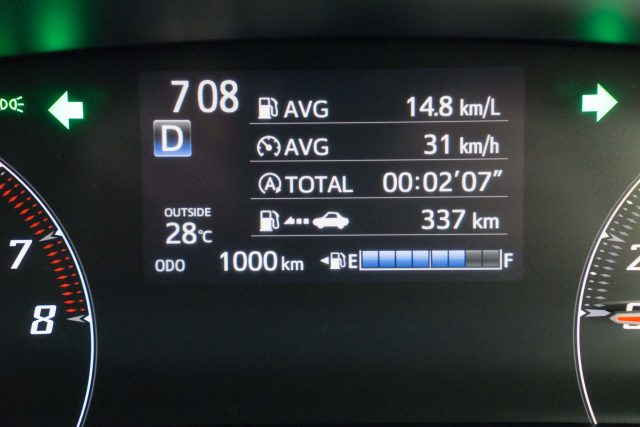
The Toyota Sienta’s engine is clearly made to be efficient. I’m clocking an average of 13km/l, with at most 30% highway driving. This includes peak hour jams on local road. Just highway driving will easily cross 20km/l!
The JDM Sienta’s engine is mated with a Super-CVT gearbox. It’s completely different on the BM Sientas, which use a slightly different and older engine, and a different CVT gearbox, but this time one that supports steptronic-style shifting. So while both JDM and BM Sientas have 1.5l engines and CVT, they are not the same.
While the Toyota Sienta is generally quite cool to drive, there are quite a few hints of cost cutting. The plasticky interior, made to look a bit like leather, isn’t quite convincing at all, and you don’t have to touch or knock on it to know. Buttons around the car, mostly, are plasticky too, and feels cheap. The bit of orange across the dashboard does add some style though.
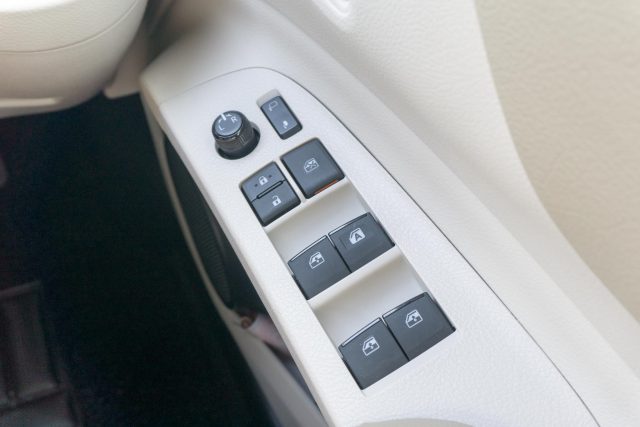
Soundproofing is comparatively poor. Plenty of road noise pours into the cabin. This is when my tyres are new, so with time, I’d expect even more noise.
I can understand that leather is expensive, and good lightweight soundproofing material may not be that cheap either. But the next one seems rather silly.
You cannot selectively turn off the aircon vents. Actually, the side ones can be turned off, by turning the louvres to the outside edge, and at the maximal position, the louvres will block off the air. There’s no way to do the same for the centre aircon vents.
Then, oddly enough, the gear shift and automatic aircon controls on the JDM “G” model (different from the automatic aircon in the BM Sienta) are actually quite good looking and feels somewhat premium.
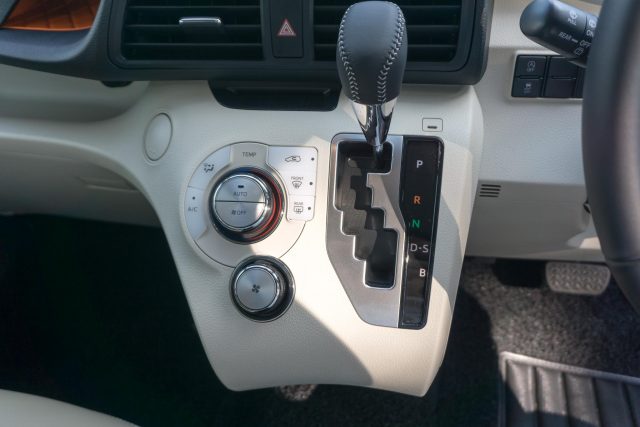
Car handling is good. The compact size, combined with small turning radius (5.2m), makes it very easy to manoeuvre around, and tight U-turns that needed to be negotiated carefully with my previous car are now a breeze. The steering is light but firm.
Visibility out of the car is good, but I did find the driver’s A-pillar somewhat obstructing a bit more than I’m comfortable with.
Suspension is good, despite the use of simpler Torsion Beam rear suspension. The front has a MacPherson Strut suspension. Ventilated and solid disc brakes are on the front and back respectively.
Standard 15-inch wheels are provided, with 185/60R15 tyres, factory upgradable to 16-inch alloys. With parallel imports, the upgrades are usually done locally instead of from factory. For my Sienta, my dealer brought me to a tyre shop to pick my own rims.
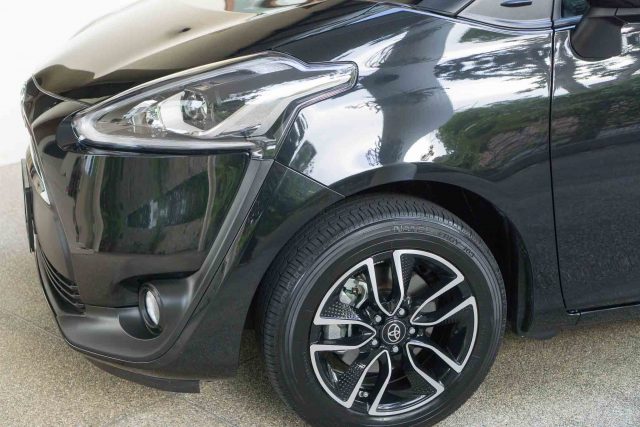
The Toyota Sienta doesn’t come with a spare tyre, although one is available as an option. Instead, Toyota provides a battery operated air pump, which you can connect to the car’s 12V power supply, and an emergency tyre repair kit.
There is still a space in the rear to stow a spare tyre though. So if you don’t put a spare tyre in there, you could use that space to stow other gear.
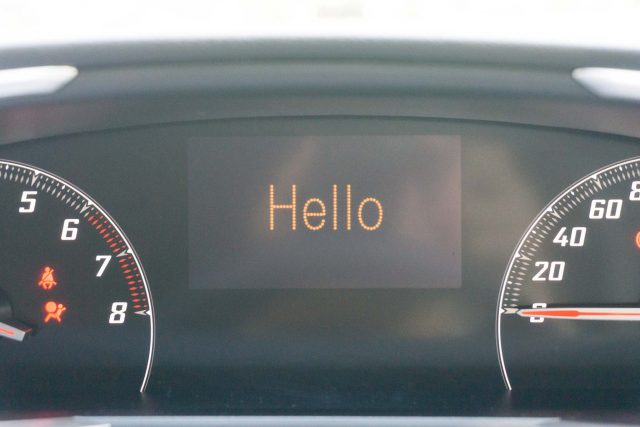
Incidentally, because I have a JDM car, most things on the car’s Multi Information Display (on “G” models) is in Japanese. The basic stuff are in English, and it should be sufficient to drive without understanding any Japanese. But if you want to do more things, and be able to read messages that appear on the display to provide you additional information, thank goodness for Google Translate.
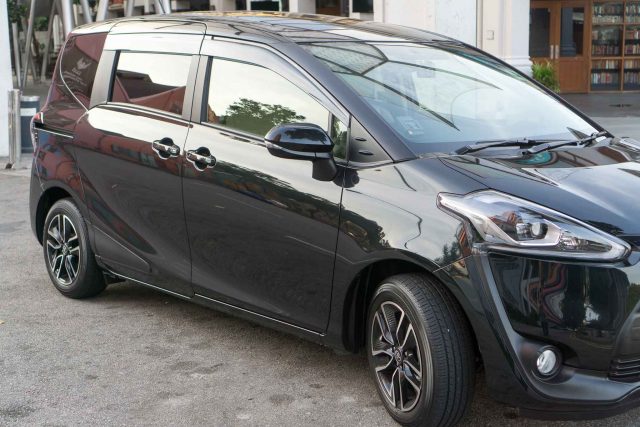
Conclusion
So overall, the Toyota Sienta is a compact MPV for mid-sized families. It’s got a cool funky look, and the interior space is quite functional.
It’s quite reasonably priced, partly due to the CEVS rebate for its fuel efficiency, as well as the smaller 1.5l engine puts it in a lower COE category.
Furthermore, expect operating costs to be low, because of better fuel efficiency, plus the fact that, again, that 1.5l engine incurs less road tax and less insurance costs.
Hi,
I like you review. Practical,factual and to the point. A good write up that is suitable for many of us to understand and associate. Thank you.
I second that!!! A pleasant review 🙂
Hi,
Good first hand review. You ran short of describing the Super- CVT gearbox. How many auto gear speed does the JDM model have?
Thank you
Hi tks for the v helpful review. Can you share which is the dealer who has the jdm sienta which can upgrade to 6 or 7 airbags? I have not been able to find. Also for the airbags upgrade isit done by Japan factory or locally?
Airbags ought to be factory installed only. I don’t remember the PI offhand, sorry. Alternatively if you are willing to wait, you could always order one to your spec.
Hi, do you have any idea if the sienta can fit 4 adults and 4 28-29″ luggage (by putting down the last row). thanks!
It’s mid 2018 now. Just wondering how the car is holding up? Any insights on maintenance costs and overall performance? Thanks and again, a very nice and pleasant write up 🙂
Excellent review! Helped me understand the differences between PI and agent units. Thanks!
Good morning my Toyota sienta 2012 changed the consumption from 13 to 7 .
I replaced the sperk plugs and still not good . what might the problem ?
Hi, may I know where is the 12V power socket? I can’t seem to locate it.
i had light up at the dashboard with Japanese wording.. with a thermostat on. when i turn off the AC.. the light goes off